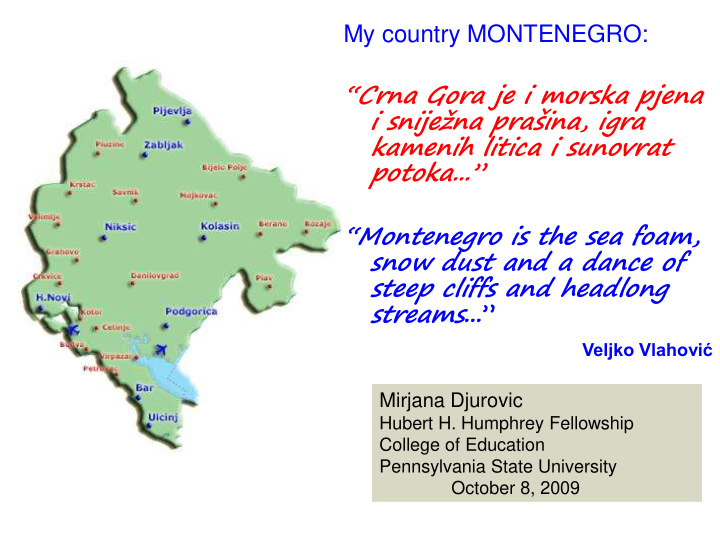



My country MONTENEGRO: “Crna Gora je i morska pjena i sniježna prašina, igra kamenih litica i sunovrat potoka...” “Montenegro is the sea foam, snow dust and a dance of steep cliffs and headlong streams ...” Veljko Vlahović Mirjana Djurovic Hubert H. Humphrey Fellowship College of Education Pennsylvania State University October 8, 2009
Montenegro • Location: South East Europe, Balkan Peninsula • Size: 13,820 km2 • Population over 630,000 • Name Through History: Duklja.. Zeta.. Crna Gora • Relief &Climate zones : mountains, continental, moderate – mediteranenan, and coastal • Rivers & lakes: canyons, glacial lakes, • National parks and sites: Durmitor, Lovćen, Biogradska Gora, Skadar lake, • People, language, religion & education • National Custom, instrument, furniture, currency and food • Famous artists and anecdotes
Montenegro has size of 0,14% of Erupe
Names of Montenegro through history: • IV Prevalitana • VII Doklea (settled by Slavic) • 1042-1360 Zeta and dynasty of Nemanjići • 1430 Crna Gora (Montenegro) • 1878 Montenegro recognized as 27th country in the world • 1910 Kingdom of Montenegro • 1919 within Kingdom of Serbia • 1929-41 in Kingdom of Yugoslavia – Zetska Banovina • 1945 SFRY- Republic of Montenegro • 2003 Serbia & Montenegro • 2006 Crna Gora -Montenegro
Flags of Montenegro
Old Montenegro Area of Montenegro was the only free and independent part during Ottoman empire “Obod”, the 1 st Cyrillic printing house on Balkan, established in 1494 in Cetinje and the Book of Psalm (Oktoih) was the 1st printed edition
High mountains with sub alpine climate , cold and snow winters and moderate summers with average temperature of 8 ° C, Plain of the Central Montenegro with modified mediterranean climate with average annual temperature of 5-25 ° C The high Dinaric mountains of Orjen, Lovcen and Rumija rise steeply from the seacoast with coastal sea, with continental climate climate having dry summers and mild, rainy winters
Mountains of Montenegro
Area of high limestone mountains, caves, holes, fields, swallys, plains
Montenegro is the 1st world proclaimed ecological state, in Zabljak 1991
National Park Durmitor under UNESCO 1st in Europe, 2nd in the protection world (78 km in length and Canyon of Tara River 1,300 meters in depth )
Rijeka Crnojevića
Ada & River Bojana
Glacial lakes
National Park: Skadar lake 40 species of fish and 264 species of birds
2833 vegetative species or 25% of European spices
Herceg Novi Risan • Boka Bay Tivat Kotor
Kotor
Risan- Roman mosaic
Krasici
Herceg Novi Herceg Novi Manastir Savina
Budva and Sveti Stefan
“Stara maslina” (Old oliv tree) in Bar Stari Bar i Rumija Ulcinj Bar
Settlements in the North of Montenegro
Podgorica, the capital
Typical village in the central area
Cetinje, the old capital
Royal theater – Zetski dom
Summer stage
King Nikola ’ s palace – Museum
House of government - National museum
Blue castel – Plavi dvorac -Museum
Former British Embassy - Music Academy
Former French Embassy – Drama faculty
Former Serbian Embassy- Ethnographical museum
Former Russian Embassy – Art Accademy
Former Bulgarian Embassy- now cafe
Former Italian Embassy – Central National Library
Former Austrian Embassy- Military building
Lov ć enska Vila and Vlash Church Memorial to Ivan Crnojević
Njegoš’s House - Museum Biljarda
Lovćen and memorial of Petar II Petrovic Njegoš, bishop, ruler, philosoph and poet
Monastery of St. Petar Cetinjski Right Hand of St. John Baptist Particle of the Blessed Cross Divinity Icon of Holy Mother Filermosa
Ostrog Monastery • Ostrog monastery was carved out of a vertical mountainside • Founded by Vasilije, the Bishop of Herzegovina known as St. Vasilije of Ostrog, • center of pilgrimage for Orthodox Christians, Catholics and Muslims
National Structure of Montenegro 33% 6% Montengrin 43% 8% Serb 33% Albanian 6% 4% Bosnian 8% Muslim 4% 1% Croat 1% 5% Others 5% 43% Average age of the population is 35,9 (male 34,8 & fimale 37,0)
Religion in Montenegro Orthodox 74% Islam 18% 18% Catholic 4% 74% Not declared 2% No religious 1% Unknown 1% 4% Other relig. 0,46% 2% 1% 1% 0%
Mother Language in Montenegro 23% 5% 6% 1 % Serbian 0% Montenegrin Albanian 1 % Bosnian Croatian Roma Other languages 64%
Educational Level for population above 15 Iliterate 2 48% 12% Uncompleted El. School 14 2% Elementary 2% school 22 Secondary school 48 University 12 14% Unnown 2 22%
“ Bravery is defending yourself from others and humanity is defending others from yourself“. Marko Miljanov Popović (1833-1901) jatagan kubura
GUSLE - National instrument single-string violin
ORO - folk dance CRNOGORSKO KOLO http://www.youtube.com/watch?v=l3urdWgafYI&feature=related
National costumes
Perper
E uro Dinar
Furiture in the village house Fireplace- OGNJIŠTE primitive stove- SAČ pot hanging on a chain- KOTAO I VERIGE
both cow's and sheep's cheese food sour cream - kajmak cheese in olive oil smoked ham smoked ham smoked ham smoked mutton ham smoked mutton ham smoked mutton ham carp, trout and eel mushrooms
MNE export Montenegrin Red Wines: White Grape Vranac, Wines: Brandy : Cabernet, Krstac, Loza, Kruna, Merlot, Chardonnay Prvijenac Vranac Pro Corde
Famous artists of Montenegro
Anecdote I am here, jogging
Recommend
More recommend